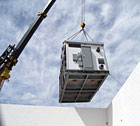
Since the commissioning of a modular central plant,
Chaparral High School in Scottsdale, Ariz., has seen electrical savings of $800
a month over its old system, according to officials.
The ability to meet a fast-track, multi-phased construction schedule and energy-efficiency goals were critical factors in the selection of a modular central plant to air condition Chaparral High School in Scottsdale, Ariz. Beating the desert heat and quiet operation were also considerations.
When all phases are complete, the new campus will span approximately 320,000 square feet across nearly a dozen buildings, some old and some new. David Peterson, assistant superintendent of the Scottsdale Unified School District, explained that demolition started in June 2006 on many of the 1970s-built campus facilities. “Construction is multi-phased over a three-year period in order to allow the school to be fully operational during the school year,” he said.
CRITICAL TIMING AND COST CONTROL
During the past summer, the installation and start-up of a McQuay modular central plant equipped with two 475-ton centrifugal chillers was made within a short time frame. This allowed newly constructed buildings to be cooled, even during finishing stages, and to serve existing buildings until their replacement or refurbishment. Peterson said, “With having to keep 2,000 students in their seats to learn, we didn’t have the luxury of the plant not functioning. And with construction costs continually increasing, it’s critical to get our projects built on time and within budget.”Peterson credited the equipment manufacturer and installing contractor, Tri City Mechanical of Chandler, Ariz., for the successful installation and commissioning of the plant following its delivery to the school in May 2007. Peterson said, “It’s important that you look at all aspects of a project. We just felt very comfortable that we had a good contractor and a good equipment manufacturer.”
The new modular plants were delivered pre-engineered and pre-assembled, with chillers, pumps, cooling towers, and interconnected piping. Units were shipped to the job site for final assembly, bypassing the need for traditional “site built” cooling plants.
“McQuay launched the modular central plant design in 2005 and since then, school districts all over the country are talking about the systems because of quality of workmanship and continued design improvements,” said Tom Marek, project director at Tri City Mechanical.

The chiller plant arrives at the jobsite as one
pre-engineered and pre-assembled module ready for final assembly and hook-ups.
MEETING THE SCHEDULE
The project team integrated the plant with new underground piping and valves. Marek explained that the entire installation process took about three weeks for bolting, wiring, and piping hookups. “It was complicated because installation needed to be completed in a short amount of time and we had to coordinate with other contractors such as electricians.” The plant runs on a decoupled primary-secondary pumping system without heating functionality. The Chaparral buildings use electric heaters, given the minimal heating requirement for the Arizona climate.Starting up and commissioning to serve the new campus over a multi-phase construction schedule upped the service and timing ante, Marek noted. For example, initial start-up of the equipment in the summer of 2007 included a temporary hookup so the new gymnasium and other buildings could be finished. “The gymnasium had to be acclimatized first so the gymnasium flooring could be installed,” he said.
The plant is internally controlled, run from a single control panel using the BACnet® open standard communication protocol, tied into the school’s Alerton® building automation system. With an eye on fighting high humidity and heat while ensuring energy efficiency, Peterson said the controls integrate well with the school’s demand ventilation system.
“Indoor air quality for us is a major concern. We develop our systems for demand ventilation which brings in fresh air as needed when we have elevated CO2 levels. We open outside air dampers as needed to balance the air.”
The plant and two cooling towers are situated next to a large gymnasium and athletic field on the campus. Peterson noted the design helps contain noise and its overall low noise rating was a selection consideration.
“You don’t want to have a machine roaring while parents are at a varsity baseball game or having noise travel across the field to homes,” Peterson said.
DOUBLE-DIGIT SAVINGS
Since the commissioning in early summer 2007, Chaparral High School has seen savings compared to its prior system in the old facilities, even given its larger footprint. “To date, we’ve added 30,000 square feet and we’ve reduced electrical usage by approximately 100,000 kilowatt hours on a monthly basis which equate to saving $8,000 in electrical costs the first month,” Peterson said.The Chaparral High School construction project will be completed in August 2008, ready for the new school year. Upon completion of all the new or refurbished buildings tied to the plant - six new buildings and three refurbished buildings, including an expanded auditorium - the school anticipates savings of 12 percent annually.
“And that’s with a total of 70,000 additional square feet over the old facilities,” Peterson said.
He also noted that scalability played into the decision to select the module central plant given any future expansion. “The fact that we can expand the plant and add more capacity to it is important,” he said.
For more information, visit www.mcquay.com.
Publication date:05/12/2008

Report Abusive Comment